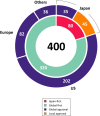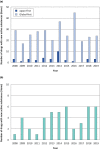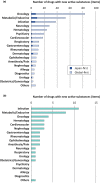Evolving Landscape of New Drug Approval in Japan and Lags from International Birth Dates: Retrospective Regulatory Analysis
- PMID: 33048367
- PMCID: PMC8246743
- DOI: 10.1002/cpt.2080
Evolving Landscape of New Drug Approval in Japan and Lags from International Birth Dates: Retrospective Regulatory Analysis
Abstract
The Pharmaceuticals and Medical Devices Agency (PMDA) has approved hundreds of new drugs in recent years. We retrospectively analyzed the new drugs approved in Japan from 2008 to 2019, and identify the first-in-world approvals and clarify the current drug lag. The new drug and the drug lag were defined as a drug with a new active substance and a difference between the approval date in Japan and the international birth date, respectively. Among 400 new drugs approved in Japan during the last 12 years, 80 (20.0%) were first approved in Japan, and 320 were outside Japan (the United States: 202, 50.5%; Europe: 82, 20.5%; other regions: 36, 9.0%). Of these, 45 new drugs have not yet been approved outside Japan, and the remaining 355 have been globally approved in Japan and overseas. The number of new drug approvals were the largest in oncology followed by metabolic/endocrine and infectious diseases. The median drug lags (year) among all 400 new drugs and 355 new drugs with global approvals were 4.3 and 4.7 in the first tertile (2008-2011), 1.5 and 2.6 in the second tertile (2012-2015), and reduced to 1.3 and 2.2 in the third tertile (2016-2019), respectively. Substantial drug lag remains in neurology, psychiatry, and therapeutic areas where the number of new drug approvals was relatively small. Collectively, one-fifth of the new drugs approved in Japan are first-in-world approvals. Drug lag has been greatly decreased, although it still exists.
© 2020 The Authors. Clinical Pharmacology & Therapeutics published by Wiley Periodicals LLC on behalf of American Society for Clinical Pharmacology and Therapeutics.
Conflict of interest statement
The authors declared no competing interests for this work.
Figures





Similar articles
-
Approval of new drugs 1999-2007: comparison of the US, the EU and Japan situations.J Clin Pharm Ther. 2010 Jun;35(3):289-301. doi: 10.1111/j.1365-2710.2009.01099.x. J Clin Pharm Ther. 2010. PMID: 20848767
-
New Drug Approvals in China: An International Comparative Analysis, 2019-2023.Drug Des Devel Ther. 2025 Apr 3;19:2629-2639. doi: 10.2147/DDDT.S514132. eCollection 2025. Drug Des Devel Ther. 2025. PMID: 40196756 Free PMC article.
-
Rationales of delay and difference in regulatory review by Japan, the USA and Europe among new drugs first approved in Japan.Br J Clin Pharmacol. 2021 Aug;87(8):3279-3291. doi: 10.1111/bcp.14749. Epub 2021 Mar 5. Br J Clin Pharmacol. 2021. PMID: 33511674
-
Analysis of 10 years drug lifecycle management (LCM) activities in the Japanese market.Drug Discov Today. 2013 Nov;18(21-22):1109-16. doi: 10.1016/j.drudis.2013.07.004. Epub 2013 Jul 12. Drug Discov Today. 2013. PMID: 23856327 Review.
-
Strategic balance of drug lifecycle management options differs between domestic and foreign companies in Japan.Expert Opin Ther Pat. 2016;26(4):497-503. doi: 10.1517/13543776.2016.1154944. Epub 2016 Mar 1. Expert Opin Ther Pat. 2016. PMID: 26881292 Review.
Cited by
-
Characteristics of Drugs from Non-Global Companies for Hematologic Malignancies and Impact on Global Regulatory Approval.Clin Pharmacol Ther. 2025 Jan;117(1):232-239. doi: 10.1002/cpt.3440. Epub 2024 Sep 10. Clin Pharmacol Ther. 2025. PMID: 39253985 Free PMC article.
-
Characteristics of Multi-Regional Clinical Trials Conducted in Asia, Focusing on Japan's Participation and Small/Medium Companies-Sponsored Trials.Ther Innov Regul Sci. 2025 Jul 16. doi: 10.1007/s43441-025-00837-4. Online ahead of print. Ther Innov Regul Sci. 2025. PMID: 40670856
-
Application of model-informed drug development (MIDD) for dose selection in regulatory submissions for drug approval in Japan.J Pharmacokinet Pharmacodyn. 2025 Jan 6;52(1):10. doi: 10.1007/s10928-024-09954-3. J Pharmacokinet Pharmacodyn. 2025. PMID: 39762622
-
Repurposing of nervous system drugs for cancer treatment: recent advances, challenges, and future perspectives.Discov Oncol. 2025 Mar 26;16(1):396. doi: 10.1007/s12672-025-02067-4. Discov Oncol. 2025. PMID: 40133751 Free PMC article. Review.
-
Pediatric-Specific Drug Loss Issue in Japan: Comparison of Pediatric Development Status Between Japan and the United States.Ther Innov Regul Sci. 2025 Jan;59(1):142-149. doi: 10.1007/s43441-024-00714-6. Epub 2024 Oct 23. Ther Innov Regul Sci. 2025. PMID: 39441417
References
-
- Hirai, Y. , Kinoshita, H. , Kusama, M. , Yasuda, K. , Sugiyama, Y. & Ono, S. Delays in new drug applications in Japan and industrial R&D strategies. Clin. Pharmacol. Ther. 87, 212–218 (2010). - PubMed
-
- Tsuji, K. & Tsutani, K. Approval of new drugs 1999–2007: comparison of the US, the EU and Japan situations. J. Clin. Pharm. Ther. 35, 289–301 (2010). - PubMed
-
- Morgan, J.P. The drug lag: good or bad? J. Am. Pharm. Assoc. 17, 553–555 (1977). - PubMed
-
- Yamada, T. , Kusama, M. , Hirai, Y. , Arnold, F. , Sugiyama, Y. & Ono, S. Analysis of pharmaceutical safety‐related regulatory actions in Japan: do tradeoffs exist between safer drugs and launch delay? Ann. Pharmacother. 44, 1976–1985 (2010). - PubMed
MeSH terms
LinkOut - more resources
Full Text Sources

